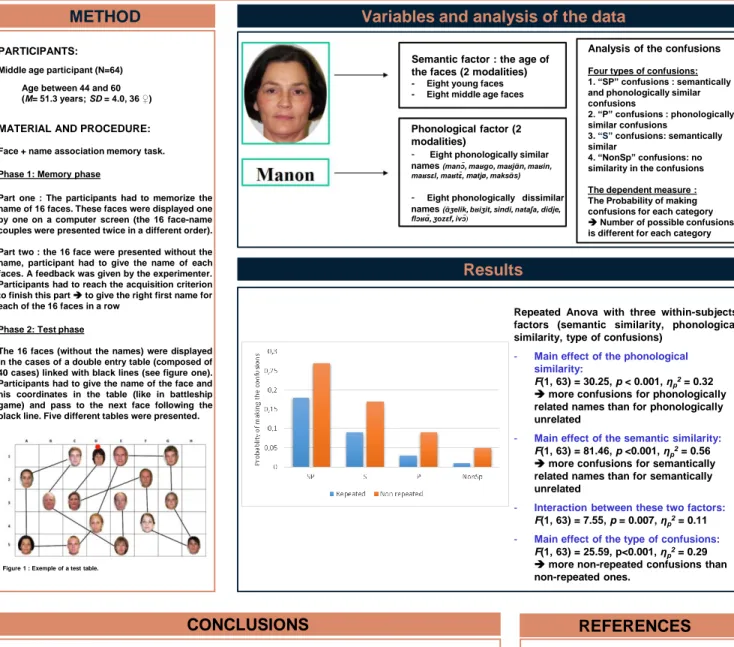The effect of semantic and phonological similarities on repeated
and non-repeated person naming confusions
Manuel Dupont*
Personal names are amongst the most difficult words to retrieve in memory even though they are very important in everyday life. Among these retrieval difficulties, we focused on the personal name confusions phenomenon (i.e. Calling someone familiar with the name of another one). The main question here is : which variables influence these naming confusions?
Two variables which are known by previous studies to influence naming confusion were studied here (see Brédart and Dardenne, 20161; Fraas and
al., 20022; Griffin and Wangerman, 20133) i.e. the semantic similarity between the bearers of the names which have been confused, and the
phonological similarity of the confused names.
To evaluate the role of these two variables we have used a face+name association memory task. The second goal of this study was to compare the repeated confusions (i.e. confound the same names more than once) with the non-repeated ones.
BACKGROUND
The phonological similarity between the confused names and the semantic similarity between the bearers of the names impacted the probability of making confusions. When similarities were present, the probability of making a confusion was higher than if there was no similarities between the names.
The studied factors impacted repeated and non-repeated confusions in the same way.
Further research is needed to investigate whether other similarities could also influence the naming confusion phenomenon.
CONCLUSIONS
REFERENCES
(1) Brédart, S., & Dardenne, B. (2016). Similarities between the target and the intruder in naturally occurring repeated person naming errors. Frontiers in psychology, 6.
(2) Fraas, M., Lockwood, J., Neils-Strunjas, J., Shidler, M., Krikorian, R., & Weiler, E. (2002). ‘What's his name?’A comparison of elderly participants' and undergraduate students' misnamings. Archives of gerontology and geriatrics,
34(2), 155-165.
(3) Griffin, Z. M., & Wangerman, T. (2013). Parents accidentally substitute similar sounding sibling names more often than dissimilar names. PloS one, 8(12), e84444.
PARTICIPANTS:
Middle age participant (N=64) Age between 44 and 60 (M= 51.3 years; SD = 4.0, 36♀)
MATERIAL AND PROCEDURE:
Face + name association memory task. Phase 1: Memory phase
Part one : The participants had to memorize the name of 16 faces. These faces were displayed one by one on a computer screen (the 16 face-name couples were presented twice in a different order). Part two : the 16 face were presented without the name, participant had to give the name of each faces. A feedback was given by the experimenter. Participants had to reach the acquisition criterion to finish this part to give the right first name for each of the 16 faces in a row
Phase 2: Test phase
The 16 faces (without the names) were displayed in the cases of a double entry table (composed of 40 cases) linked with black lines (see figure one). Participants had to give the name of the face and his coordinates in the table (like in battleship game) and pass to the next face following the black line. Five different tables were presented.
Figure 1 : Exemple of a test table.
METHOD
Variables and analysis of the data
* University of Liège, Liège, Belgium
Psychology and Neuroscience of Cognition Research Unit (PsyNCog)
Contact: m.dupont@ulg.ac.be
Repeated Anova with three within-subjects factors (semantic similarity, phonological similarity, type of confusions)
- Main effect of the phonological similarity:
F(1, 63) = 30.25, p < 0.001, ƞp2= 0.32
more confusions for phonologically related names than for phonologically unrelated
- Main effect of the semantic similarity:
F(1, 63) = 81.46, p <0.001, ƞp2= 0.56
more confusions for semantically related names than for semantically unrelated
- Interaction between these two factors:
F(1, 63) = 7.55, p = 0.007, ƞp2= 0.11
- Main effect of the type of confusions:
F(1, 63) = 25.59, p<0.001, ƞp2= 0.29
more non-repeated confusions than non-repeated ones.
Results
Analysis of the confusions
Four types of confusions: 1. “SP” confusions : semantically and phonologically similar confusions 2. “P” confusions : phonologically similar confusions 3. “S” confusions: semantically similar 4. “NonSp” confusions: no similarity in the confusions The dependent measure : The Probability of making confusions for each category
Number of possible confusions
is different for each category
Semantic factor : the age of the faces (2 modalities)
- Eight young faces - Eight middle age faces
Phonological factor (2 modalities)
- Eight phonologically similar names (manɔ̃, maʁɡo, maʁjɑ̃n, maʁin, maʁsɛl, maʁtɛ̃, matjø, maksɑ̃s)
- Eight phonologically dissimilar names (ɑ̃ʒelik, bʁiʒit, sindi, nataʃa, didje, flɔʁɑ̃, ʒozɛf, ivɔ̃)
